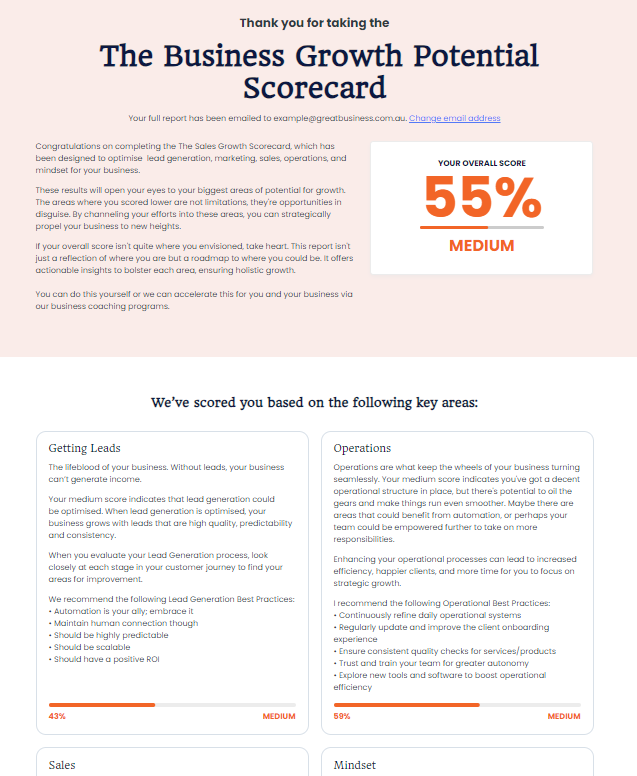So, you’re on a mission to accelerate your business growth, strategically.
Maybe you’re a solopreneur eager to elevate your brand to the next level. Or maybe you operate a small business with a handful of employees or contractors, and you’re itching to tap into a wider customer base.
No matter what your circumstances are, you’ve likely found yourself pondering, “What are the proven strategies to speed up my business growth?”
That’s an excellent question, and I’m glad you’re doing the research first on how to do it strategically.
Believe it or not, growing too quickly can also be a pitfall. Two-thirds of the fastest-growing start-ups end up failing.
It might sound counterintuitive, but here’s the truth:
Not all growth is beneficial.
In fact, the wrong kind of growth can spell catastrophe for your business.
That’s why it’s absolutely critical to nail the growth of your business the RIGHT way.
To dodge the bullet of becoming a mere statistic, you need the RIGHT strategies for growth.
The journey begins with understanding what successful acceleration looks like.
So, buckle up. I’m about to guide you through proven strategies to accelerate your business growth. Because getting it right could make the difference between your business thriving with vitality and longevity…
Or becoming a distant memory.
What is a Business Growth Strategy?
You’re ready for growth, but where do you start? What does a business growth strategy even look like?
A business growth strategy is, quite simply, your roadmap to achieving long-term business goals. It’s a plan that sets out your current position, your desired future, and the steps you need to take to get there.
Why is it essential? It’s your compass in the competitive business landscape. It steers you around the challenges of competition, market fluctuations, and financial pitfalls. Acting as your business’s GPS, it helps you stay on course and continue to thrive amidst uncertainty. Without a sturdy growth strategy, you risk just drifting instead of moving purposefully towards growth.
Now we’re clear on what a business growth strategy is and its importance, we can explore the different types of growth strategies and how they can push your business ahead.

Why You Need a Growth Strategy?
You might be asking, why do I need a growth strategy? Just as a ship wouldn’t venture into uncharted waters without a navigation plan, a business shouldn’t pursue growth without a strategy.
Here’s why:
A Clear Vision
A growth strategy helps you crystallise your business vision. Where do you want your business to be in five years? Ten years? A growth strategy defines your goals and outlines the steps needed to achieve them.
Improved Decision Making
With a clear vision comes the ability to make informed decisions. When faced with a business decision, you can refer to your growth strategy to ensure your choices align with your long-term goals.
Resource Allocation
A growth strategy also guides resource allocation. It helps you decide where to invest your time, money, and efforts to maximise growth. Without a strategy, you could end up wasting resources on initiatives that don’t align with your business goals.
Competitive Advantage
A well-crafted growth strategy can give you an edge over your competitors. It allows you to anticipate market trends, adapt to changes, and stay ahead of the curve. It’s not just about surviving in your industry; it’s about thriving.
Mitigating Risks
Growth comes with risks. A growth strategy helps you identify potential pitfalls and plan for them. It allows you to manage risks proactively rather than reacting to them after the fact.
Employee Engagement and Retention
A clear growth strategy can also boost employee engagement and retention. When your team understands the company’s direction and their role in achieving the company’s goals, they’re more likely to feel valued and committed to your business.
Basically, a business growth strategy isn’t a luxury—it’s a necessity. No matter how small or large your business, having a growth strategy can pave the way for sustainable and profitable growth.

Types of Business Growth Strategies
As you continue your journey to business growth, you’ll encounter various strategies, each with its unique path. Understanding these different types will empower you to select the one that’s most suitable for your business.
Here are several common types of business growth strategies:
1. Market Penetration
Market Penetration involves digging deep into an existing market with your current products or services. The goal is to obtain more market share in the current market segment, either by enticing customers from competitors or making current customers buy more.
Benefits of Market Penetration Strategy
Low Risk: As you’re dealing with a familiar market and product, the risk is relatively low compared to other strategies.
Increased Market Share: Successfully penetrating a market can significantly increase your market share, enhancing your competitive position.
Economies of Scale: Higher sales volume can lead to economies of scale, which can lower production costs and increase profitability.
Challenges of Market Penetration Strategy
High Competition: Since market penetration oftenmeans competing in an existing market, you’ll likely face stiff competition. Differentiating your offerings or effectively undercutting competitors on price can be difficult.
Customer Acquisition Costs: To attract customers from your competitors, you might need to invest heavily in marketing and promotional activities. This could raise your customer acquisition cost.
Limited Market: In a saturated market, there may be limited room for growth. You might find that once you’ve reached a certain point, further penetration becomes progressively harder.
Approaches to Market Penetration Strategy
Promotion: Investing in marketing and advertising can raise awareness of your offerings. This could involve traditional methods like print and TV ads, as well as digital marketing strategies like SEO and social media campaigns.
Product Improvement: Continually improving your products or services can help you stand out from your competitors. This might involve introducing new features, improving user experience, or addressing customer pain points more effectively than your competitors.
Distribution: Expanding your distribution channels can also contribute to market penetration. For instance, you might consider selling online if you’re currently only selling in physical stores.
Pricing: Offering your products or services at a lower price than your competitors is a common approach (although not something I usually recommend). This could be effective if you can achieve economies of scale that allow you to maintain high profitability even at the lower price point.
Well-known examples of market penetration strategies
Spotify
In the crowded music streaming market, Spotify differentiated itself by enhancing the user experience with unique features like Discover Weekly and Daily Mix playlists. These personalised offerings not only attracted new users but also boosted usage among existing customers.
Coca-Cola’s ‘Share a Coke’
Coca-Cola’s ‘Share a Coke’ campaign is a hallmark of an innovative promotional market penetration strategy. To combat falling soda consumption, Coca-Cola invited people to ‘Share a Coke’ by replacing their logo with common names and phrases on their bottles. The result was a substantial increase in summer sales and massive social media engagement, effectively penetrating further into the market.
With this strategy in your arsenal, you can inch your way into dominating your existing market, and that’s a fantastic growth opportunity!
2. Market Development
Market Development is a growth strategy where you sell your existing products or services into new markets. This could involve targeting new geographical areas, new demographic segments, or new usage occasions.
Benefits of Market Development Strategy
New Revenue Streams: Entering new markets creates new opportunities for revenue growth. Each new market has potential customers waiting to be tapped into.
Diversification: By spreading the business across multiple markets, you can reduce the risks associated with dependency on a single market.
Competitive Advantage: Early entry into a new market can give you a competitive edge. You can establish your brand and build customer relationships before your competitors.
Challenges of Market Development Strategy
Market Research: Understanding a new market requires thorough market research. This can be time-consuming and expensive.
Cultural Differences: If you’re expanding into a new geographical region, you may face cultural and language barriers. You’ll need to adapt your marketing strategies accordingly.
Regulatory Hurdles: Each new market comes with its own set of regulations and legal considerations. Navigating these can be tricky.
Approaches to Market Development Strategy
New Geographic Markets: This could involve expanding from local to regional, regional to national, or national to international. You might open new stores, work with distributors, or sell online to reach customers in these areas.
New Customer Segments: You could identify new demographic segments who could benefit from your product. For instance, a toy manufacturer targeting children might find a new market segment in adult collectors.
New Channels: Selling through different channels can also open up new markets. For example, if you’ve only sold products in a physical store, launching an e-commerce site can reach online customers.
Well-known examples of Market Development Strategy
Example: Starbucks in China
When we talk about geographical market development, Starbucks’ entry into China is a fantastic example. Starbucks adapted its store design and menu to appeal to local tastes while maintaining its global brand image. Today, China is Starbucks’ second-largest market, demonstrating the power of effective geographical market development.
Example: LEGO’s Appeal to Adults
On the other hand, LEGO’s strategy to target adult consumers represents successful market development into a new customer segment. Traditionally a kid’s toy, LEGO realised that adults also enjoyed their products for their intricate design and stress-relieving qualities. By releasing complex sets and promoting LEGO as a creative outlet for adults, the company successfully opened up a whole new demographic market.
Armed with a market development strategy, your business has the potential to reach new customer segments and explore new geographical horizons. It’s an adventurous journey towards growth and one that can yield rewarding results.
3. Product Development
Product development involves creating new products or improving existing ones to offer to your current market. This strategy is about innovation and enhancement, bringing something new or improved to the table that your existing customers will value.
Benefits of Product Development Strategy
Increased Revenue: With each new product you introduce, you open up opportunities for additional sales and increased revenue.
Competitive Advantage: Continuous innovation can set you apart from your competitors, giving you a competitive edge.
Customer Loyalty: When you continuously provide value to your customers through new or improved products, you strengthen your relationship with them, fostering loyalty.
Challenges of Product Development Strategy
High Costs: Developing a new product can be expensive. It involves research and development, testing, marketing, and more.
Risk of Failure: Not every new product will be a hit. There’s always the risk that your new product won’t resonate with your customers as expected.
Time-Consuming: Product development takes time. It’s a process of trial and error, learning and improving.
Approaches to Product Development Strategy
Customer Feedback: Listening to your customers can provide valuable insights for product development. They can tell you what they like, what they don’t like, and what they wish they had.
Market Research: Keeping an eye on market trends and competitors can also guide your product development. You can learn from others’ successes and failures.
Innovation: Encouraging an innovative culture within your business can lead to unique and competitive product ideas.
Well-known examples of product development strategy
Now, let’s look at a couple of examples of successful product development strategies.
Example: Google’s Evolution
Google began as a simple search engine. Today, it offers a whole suite of products, from Gmail and Google Maps to Google Docs and Google Drive, all designed to enhance the user’s online experience. Google’s continuous product development, driven by a clear understanding of their customers’ needs, has played a huge role in their global success.
Example: Dyson’s Vacuum Revolution
Dyson is another company that thrives on product development. Their innovative bagless vacuum cleaner revolutionised the market, and they’ve continued to innovate ever since, with new products like bladeless fans and cordless vacuum cleaners. Dyson’s commitment to improving and reinventing products based on customer feedback and advanced engineering demonstrates the power of product development in driving business growth.
With a product development strategy, you’re continuously improving, innovating, and enhancing. It’s a journey of creativity and invention, keeping you on your toes and your customers eagerly waiting for what you’ll come up with next.
4. Diversification
Diversification is a growth strategy that involves expanding into new markets with new products. It’s like venturing into unexplored territory, bringing with it both opportunities for substantial growth and risks.
Benefits of Diversification Strategy
New Revenue Streams: Diversification can open up new revenue streams by reaching new customers and markets.
Risk Spreading: Diversification helps to spread the risk. If one product or market is underperforming, others may compensate.
Brand Strengthening: Successfully diversifying can strengthen your brand by demonstrating adaptability and innovation.
Challenges of Diversification Strategy
High Risk: Diversification involves moving into unknown territory. The new market may not respond positively to your product, or the product itself may not perform as expected.
Resource Intensive: Diversification requires significant resources, including time, money, and effort. You’ll need to develop new products, research new markets, and implement new marketing strategies.
Potential Distraction: Pursuing diversification could distract you from your core business if not managed properly.
Approaches to Diversification Strategy
Market Research: Thorough market research is crucial before entering a new market. You need to understand the market dynamics, customer needs, and competitive landscape.
Strategic Partnerships: Partnering with a company that already operates in your target market can help mitigate the risks of diversification. They can provide valuable insights, resources, and credibility.
Incremental Steps: Taking small, incremental steps into the new market or product can help manage the risks. Test your product in the new market, gather feedback, and refine before a full-scale launch.
Let’s take a look at a couple of companies that have successfully used diversification as a growth strategy.
Well-known examples of diversification strategy
Example: Virgin Group’s Portfolio
Virgin Group is the epitome of a successful diversification strategy. Starting with a record shop, they’ve expanded into a multitude of sectors, from airlines and trains to finance and space travel. Their successful diversification is driven by their brand’s strong identity and reputation for shaking up sectors with innovative, customer-focused approaches.
Example: Amazon’s Expansion
Amazon started as an online bookstore. Today, it’s a global marketplace, a streaming service, a hardware manufacturer, and even a grocery chain. This diversification was achieved through a combination of market understanding, innovation, and strategic acquisitions.
Diversification is not for the faint-hearted. It involves embracing uncertainty and being willing to take calculated risks. But if done right, it can open up a world of possibilities for your business. Are you ready to take the leap?
5. Acquisition
An acquisition is a growth strategy where you buy another company to expand your operations. This could mean purchasing a competitor, a supplier, a distributor, or even a business that’s in a completely different industry.
Benefits of Acquisition Strategy
Instant Access to New Markets: Acquiring a business can give you instant access to its existing customer base, geographical reach, or product offerings.
Competitive Edge: Acquisitions can eliminate competition or add valuable assets, like patented technology, to your arsenal, giving you an edge in the marketplace.
Cost and Time Efficiency: Developing new products, customers, or markets from scratch can be costly and time-consuming. An acquisition can offer a quicker route to growth.
Challenges of Acquisition Strategy
High Cost: Acquisitions can be costly, not just in terms of purchase price, but also the associated legal, financial, and integration costs.
Cultural Clash: Every company has its own culture. A mismatch in company cultures can lead to employee dissatisfaction and can even disrupt operations.
Complexity: Acquisitions involve complex processes, including due diligence, negotiation, integration, and change management.
Approaches to Acquisition Strategy
There are primarily two types of acquisitions, depending on the direction of integration – vertical and horizontal.
Vertical Integration: This involves acquiring a business in your supply chain. This could either be a supplier (backward integration) or a distributor (forward integration). Vertical integration can give you greater control over your supply chain and can lead to cost savings and efficiency gains.
Horizontal Integration: This involves acquiring a business that operates in the same industry and market as yours, like a direct competitor. Horizontal integration can increase your market share, reduce competition, and lead to economies of scale.
Well-known examples of acquisition strategy
Let’s have a look at a couple of examples of successful acquisition strategies.
Example: Facebook’s Acquisition of Instagram and WhatsApp
Facebook’s acquisitions of Instagram and WhatsApp are classic examples of successful horizontal integrations. Through these acquisitions, Facebook eliminated two potential competitors, gained access to new user groups, and reinforced its dominance in the social media space.
Example: Amazon’s Acquisition of Whole Foods
Amazon’s acquisition of Whole Foods is an example of forward vertical integration. It gave the e-commerce giant a brick-and-mortar presence, adding a new dimension to its business model and access to a new customer base.
Acquisition can be a powerful way to supercharge your growth. But remember, it’s essential to perform thorough due diligence and have a clear integration plan in place to make the most of this growth strategy.
6. Partnerships & Strategic Alliances
Strategic partnerships or alliances can be a powerful way to boost your business growth. This involves collaborating with another business to achieve mutual goals. The collaboration can take various forms, such as joint ventures, affiliate partnerships, or even licensing agreements.
Benefits of Partnerships & Strategic Alliances
Shared Risks and Costs: Partnerships allow businesses to share the risks and costs associated with new ventures. It can provide a safety net, especially for riskier ventures.
Access to New Markets: A partnership with a business that operates in a different market can give you access to its audience, thereby expanding your market reach.
Leverage Complementary Skills and Resources: A strategic alliance can bring together complementary skills, resources, and expertise. This can increase the overall competitiveness and capabilities of your business.
Challenges of Partnerships & Strategic Alliances
Compatibility Issues: Successful partnerships require compatible cultures, goals, and management styles. Differences in these areas can lead to misunderstandings and conflicts.
Sharing Profits: While partnerships allow for shared costs and risks, they also mean shared profits. It’s crucial to have clear agreements about profit sharing to prevent disputes later.
Risk of Dependence: Partnerships can sometimes lead to over-dependence on one partner. If one business becomes reliant on the other’s resources or customer base, it could become vulnerable.
Approaches to Partnerships & Strategic Alliances
Joint Ventures: Two or more businesses create a separate legal entity to pursue a specific business objective. Each business contributes to and has a stake in the new entity.
Affiliate Partnerships: One business promotes another’s products or services in exchange for a commission on the sales it generates.
Licensing Agreements: One business gives another the right to use its intellectual property, such as patents or trademarks, in exchange for royalty payments.
Let’s look at two examples of strategic partnerships that turbocharged business growth.
Well-known examples of Partnerships & Strategic Alliances
Example: Spotify and Starbucks
In a strategic alliance, Spotify provided Starbucks with its streaming platform to create a music program. Starbucks baristas became DJ’s curating music playlists for their stores. The partnership gave Spotify access to Starbucks’ massive customer base, while Starbucks could enhance the in-store experience with tailored music.
Example: Google and NASA
Google and NASA entered a partnership where Google leased land from NASA to build a research facility. In return, Google provided NASA with access to its computing resources. This partnership allowed both entities to benefit from each other’s unique resources and expertise.
Partnerships and strategic alliances can be a win-win way to spur business growth.
Each of these strategies has its own potential benefits and risks, and it’s important to carefully consider which one is most suitable for your business before proceeding. Sometimes, a combination of several strategies is used, depending on the specific circumstances and goals of the business. Remember, the key is to select a strategy that aligns with your overall business goals and resources.

What Makes a Business Growth Strategy Effective?
Creating a growth strategy is one thing, but crafting one that delivers results? That’s where the magic lies. So, what separates an effective growth strategy from one that just gathers dust on your shelf?
1. Alignment with Your Business Vision: Your growth strategy needs to be grounded in the vision of your business. It should not only be a roadmap to achieving your short-term objectives but also direct your business towards its ultimate long-term goals.
2. Understanding of Your Target Market: The more you understand about your target customers – their needs, preferences, and pain points – the more effective your strategy will be. Insight into your target market guides product development, marketing, and customer service efforts.
3. Clear and Measurable Goals: Your growth strategy should lay out clear, specific, and measurable goals. This makes it easier to track your progress and make necessary adjustments.
4. Flexibility: While a growth strategy sets a course, it shouldn’t be rigid. The business environment is constantly evolving, and your strategy should be flexible enough to adapt to these changes.
5. Resource Allocation: Effective strategies provide a guide for resource allocation. They outline where to invest time, money, and effort to get the best return on investment.
6. Buy-in from Stakeholders: Lastly, for a strategy to be effective, it must have buy-in from all stakeholders, including employees, partners, and investors. They should understand the strategy and their role in implementing it.
A growth strategy that checks all these boxes is more likely to propel your business forward. And remember, a strategy is not something you set and forget. Regular review and adjustments are key to keeping your business on the growth trajectory.
How to Create a Growth Strategy
Creating a successful growth strategy might sound intimidating, but I assure you, it doesn’t have to be. Let’s break it down into manageable steps.
1. Understand Your Vision: Your vision is the ultimate goal for your business. What does success look like to you? More customers? A global presence? Being a household name? Before you plot the path, you need to know the destination.
2. Conduct a SWOT Analysis: Take an objective look at your business. Identify your Strengths, Weaknesses, Opportunities, and Threats (SWOT). This gives you a clear understanding of where your business stands and the challenges it might face.
3. Define Your Goals: Now, outline your business goals. These should be specific, measurable, achievable, relevant, and time-bound (SMART).
4. Understand Your Customers: To grow, you need to know who you’re selling to. Understand your target customers and tailor your offerings to meet their needs.
5. Decide on the Growth Strategy: With the groundwork laid, it’s time to decide on the most suitable growth strategy. This could be one or a combination of the growth strategies we discussed earlier.
6. Develop an Action Plan: An action plan lays out the steps to implement your strategy. It defines what actions need to be taken, by whom, and by when.
7. Allocate Resources: Your strategy should also outline how resources—money, time, and personnel—will be allocated. This includes the investment required and the potential return on investment.
8. Communicate Your Strategy: Once you’ve outlined your strategy, communicate it to all stakeholders. This includes employees, investors, and partners.
9. Monitor Progress: Once the strategy is in motion, monitor its progress. Is it yielding the desired results? If not, what needs to be adjusted?
How to Grow a Business Successfully
Growing a business successfully involves more than just creating a killer growth strategy. It’s about nurturing all aspects of your business to ensure it can handle that growth and thrive. Here are the key components:
1. Marketing: Without marketing, your business is like a star in the sky – beautiful but hard to find. Investing in effective marketing strategies can put your business on the map and attract new customers. This might involve SEO, social media marketing, content marketing, email marketing, and more.
2. Sales: Once your marketing efforts have drawn in potential customers, your sales team must convert them into paying customers. This involves understanding customer needs, offering solutions, and closing the deal.
3. Product Development: As we discussed in the growth strategies section, product development can be a key driver for business growth. This involves continually improving existing products or introducing new ones to meet the evolving needs of your customers.
4. Customer Relations: Keeping your customers happy should be a top priority. Happy customers not only come back for more, they also spread the word about your business. This can be achieved by providing excellent customer service, seeking and acting on customer feedback, and nurturing relationships with your customers.
5. Financial Management: To support your growth plans, you need to keep a close eye on your finances. This involves budgeting, tracking expenses, managing cash flow, and making informed financial decisions.
6. Team Development: Your team is your most valuable asset. Investing in their development can boost productivity, enhance skills, and improve employee retention.
7. Scalability: As your business grows, you’ll need systems that can handle that growth. Whether it’s your supply chain, customer service, or IT systems, ensuring they are scalable is crucial for smooth growth.
Growth isn’t a one-size-fits-all concept. It’s about making smart decisions that align with your business vision and goals.

Wrapping Up: Embrace Your Potential and Create Sustainable Business Growth
We’ve travelled quite a journey together through the landscape of business growth strategies, haven’t we? From understanding the importance of having a well-defined strategy to exploring various types of strategies and best practices for implementation.
Growing a business isn’t a walk in the park. It requires careful planning, smart decision-making, and a good dose of resilience. But with a solid growth strategy in place, you’ll have a roadmap guiding you through the ups and downs, helping you make the most of opportunities, and steering you clear of potential pitfalls.
Remember, every business is unique, and what worked for one might not work for another. It’s essential to pick a strategy that aligns with your business goals, resources, and the market environment.
But you don’t have to do it all alone! As a small business coach, I’ve helped hundreds of business owners to make more money and grow their businesses without burning out. I can help you too.
Where To From Here
Are you ready to fast-track the growth of your business? Want to find out how I can help you create and implement a growth strategy tailored to your business? Then let’s chat. Book a discovery call with me, and let’s start building your path to success. I can’t wait to see where your business growth strategies will take you!
Remember, growth isn’t just possible. It’s within your reach. You just have to create the strategy and implement it. Keep pushing, keep striving. You’ve got this!









